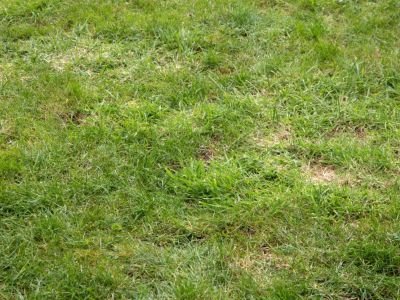The best time to fill uneven lawn low spots is during vigorous growth, which usually depends on the type of grass grown but normally during spring and summer.
Should You Level a Lawn Using Sand?
Sand is oftentimes used to level lawns, but putting sand on lawns can cause problems. You should never use pure sand to level a lawn. Most lawns contain a lot of clay, which already makes growing grass difficult. However, adding pure sand on top of the clay only creates further problems by turning the soil into a nearly hardened cement-like consistency, as drainage abilities are worsened. Sand also dries out rapidly in summer, causing any grass that may be growing to suffer in the heat. Grass growing in the sand is also more susceptible to drought and cold injury. Avoid putting sand on a lawn by itself. Using a dry topsoil and sand mix is much better for leveling uneven areas than putting sand on a lawn without mixing.
Filling Low Spots in the Lawn
You can easily make your own lawn patching soil by mixing sand and dry topsoil in equal parts of half-and-half, spreading the leveling mix into low-lying areas of the lawn. Some people also use compost, which is great for enriching the soil. Only add one-half inch (1.5 cm.) of soil mix to the low spots at a time, leaving any existing grass showing through. After leveling, fertilize lightly and water the lawn thoroughly. You may still notice some low areas in the lawn but it’s oftentimes best to allow the grass to grow up through the soil for at least a month before repeating the process. After about four to six weeks, another half-inch (1.5 cm.) of the dry topsoil mix can be added to the remaining areas. Keep in mind that deeper areas of the lawn, which are more than an inch (2.5 cm.) lower than the soil, require a slightly different approach. To fill uneven lawn low spots like these, first remove the grass with a shovel and fill in the depression with soil mix, laying the grass back in place. Water and fertilize thoroughly. Now that you know how to level a lawn, you do not need to go out and hire an expensive professional. With a little time and effort, you can fill uneven lawn ruts and indentations in no time.
